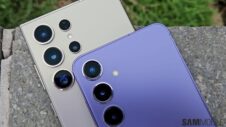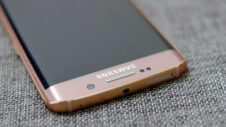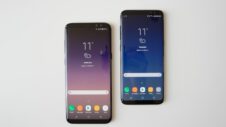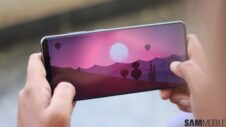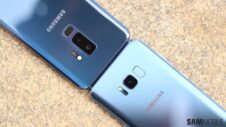The Galaxy Note 7 has been announced, with curved edges intact, leading many to look ahead and wonder if the Galaxy S8 in 2017 will see the same treatment: the flat S8 tossed out, the Galaxy S8 edge hailed as the true S flagship. It's a question worth pondering, especially since tech is a field committed to moving forward, looking ahead, making logical predictions about what's to come and what's right around the corner. With the Galaxy S8 in 2017 to arrive in a matter of months, it makes sense to ask this question now rather than later.
Displaying the Evidence: Could Samsung release only the Galaxy S8 edge in 2017?
Could Samsung release a Galaxy S8 edge as the S flagship in 2017? In a word, “yes.” Then again, “could” implies “might,” possibility, potentiality, a small opportunity. It isn't a confident-proof answer, but one that says there's some measure of possibility, even probability, that lends credence to the idea. Then and again, tech isn't always as predictable and certain as some would believe, either.
The evidence for the Galaxy S8 edge as the sole S flagship for next year comes from Samsung's decision to “go all in on the edge” this year with the Galaxy Note 7. There is no flat Galaxy Note 7, despite all the existent prototype photos that continue to be propagated across the interwebs. And yes, I'm aware of consumers that just aren't happy with living on the edge and prefer that Samsung would choose to live in their flat reality instead (I'll leave interpretations of what I mean by this statement up to your conscience).
In any case, Samsung could go all in and release only one S model, the Galaxy S8 edge, instead of a flat Galaxy S8 and a curved Galaxy S8 edge (the Korean giant seems open to the idea). Why? Because of the edge's success. Just take a look at the Galaxy S7 edge, and one thing becomes perfectly clear: consumers want the edge (a large number do, anyway).
The same can be said for the Galaxy Note 7: diehard Galaxy Note fans who had the Galaxy Note Edge were dying to see a sequel but were denied this right last year. With all the pent-up demand for the Galaxy Note and the curved edges, Samsung finally brought the two features together that, for me and countless others, make the perfect recipe for the perfect device.
One could also look back at the Galaxy S6 edge to see that the demand for Samsung's edge displays even overwhelmed the company behind them! And that demand hasn't ceased since 2015, which means that the consumer market, not just Samsung, has also “turned over a new leaf” in its expectations of what a quality smartphone should be and have.
In other words, the market has changed: the edge is cool, futuristic, and “in,” and no company paying close attention to the market would deny that. Lesser-known Android OEMs could only dream of having the consumer market as firmly planted in their grasp as Samsung.
Should the Galaxy S8 edge serve as the sole Galaxy S8 flagship in 2017?
At this point, we should move into the discussion that every tech diehard wants to have. Yes, we can talk about what it seems likely Samsung will do, but deep down, true tech diehards long to be analytical. If you've ever commented on a tech site, congratulations; you share this goal.
Should Samsung release only the Galaxy S8 edge in 2017, no regular, flat, box-form Galaxy S8? For me at least, the answer to this question is yes. After all, the edge is now in its second full year on the market (the Galaxy Note Edge arrived at the end of 2014 rather than the beginning), and after two years of the edge, consumers who are buying and using the edge have an expectation that Samsung will support the edge and that the edge is something more than just a dabbling experiment.
I've said before that Samsung experiments on its high-end Galaxies with good reason, and experiments in initial R&D are good. I expect any tech company that considers itself on the front lines of doing its job to experiment. Experimentation is the means by which innovation comes, and any company that only makes slight tweaks each year without any long-term investments in futuristic tech cannot continue to call itself a tech company.
With that said, however, experimentation for experiment's sake doesn't come to a good end. Samsung has been pushing forward with the edge for 2 years now, but the internal company angst in decision between the curved edge Galaxy Note 7 and the flat-box prototype (that has only further teased angry customers and fans) does little to suggest to the world that Samsung is going all in on the edge and that the Korean giant is committed to it; instead, it sends the wrong impression that Samsung is only going in on the edge because it's popular and that the box-form factor trumpets could storm the battlefield again at any time.
Samsung seems to be committed to the edge, but at some point (this could be behind us already), Samsung has to step up and commit to the edge, give a “this-is-what-we're-doing-long-term” sort of stance. At some point, the Korean giant has to live or die on the edge, regardless of what the critics and haters think.
After all, to bring its own trademark designs to market under its own brand is the goal of any smartphone OEM, regardless of what they may or may not say publicly. Samsung is in the perfect position to achieve this and make the edge the start of a new design chapter in the smartphone market and in smartphone history.
I think it would be a major shame for Samsung to continue to “flirt with the edge” while still flirting and maintaining a long-standing relationship with flat box-form design in order to keep some long-standing consumers happy – only to see some company come along, commit to it, and then have Samsung get little credit down the line for what was solely the company's own trademark design. No matter how great an idea may or may not be, the first one to go public and push forward is the one who gets the glory. No matter how refined an OEM's design may be 5 years from now, no one exalts or glorifies second or third place.
With the eyes of Chinese OEMs on the edge, and Android as a whole eyeing what has been seen as something of an experiment for now, it's time for Samsung to go all in and buckle down on this new chapter. After all, this is the company known for bringing consumers “what's next, now,” not waiting around for the next to become the now before delivering it to consumers.
Going all in with a dual-edge Galaxy S8: Samsung's chance to display its own vision to the world
Sometimes in the race to give consumers what they want, OEMs make concessions. There's nothing wrong with this: after all, it's normal to want your products to become a favorite, a household name, to create a brand that everyone is aware of. And yet, Samsung is already there. The company is not standing around waiting for that magic moment. Samsung isn't trying to work hard to get there because the company has already made it to the top of the game. It's hard to find one person in 2016 that doesn't know about the Galaxy Note lineup, or that the Galaxy Note 7 was just announced days ago.
And yet, it's also the case that consumers can't always articulate what they want (if you're a person that discovered you loved something that you didn't know you needed before Samsung brought it to the Galaxy S or Galaxy Note series, congrats; you've witnessed this firsthand). The illusion given in the smartphone market is that consumers know what they want and that manufacturers “better give it to 'em,” but this is partially true and partially an illusion.
Consumers know to some extent what they want: many want a phone with the latest technology that looks good and runs well. And yet, that last statement is extremely vague. What does it look like for a smartphone to look good? For LG, that has been answered in the way of metal, semi-modular design, while Samsung has answered that statement with the dual-edge display.
Why do these two Korean manufacturers answer the idea of “look good” and “run well” in different ways? The answer lies in the fact that, in the case of extremely vague statements, OEMs must interpret in their own way what such statements mean.
Customers know from year to year that “I want something different,” but they don't always know the nature of what “different” may be. It is up to manufacturers to interpret that and bring unique, creative “takes” on vague statements to market. This is why customers wait each year to “see what x company does,” they often say.
The edge is Samsung's own answer to the consumer desire that his or her phone “look good” and “run well.” And in answering the consumer desire with the edge, it is, in short, Samsung's own tech vision that the company can display to the world with the Galaxy S8 edge in 2017. If the device will be called the Samsung Galaxy S8, then does Samsung not have a voice regarding the phone's design?
Conclusion
LG isn't in the most desirable position at this point, and after the disaster of the G5, could easily have reconsidered ditching the modular movement and gone back to an LG G3 or LG G4 smartphone design in an effort to appease its predictable customer base and make easy profit. Sadly, in this market, there are a number of Android OEMs that would've done just that in an effort to please investors and make some serious cash.
Though using the LG G5 hasn't convinced me that “modular” is my thing (you may feel the same thing about Samsung's dual-edge displays), LG is to be respected for taking a bold initiative in a market full of OEMs that simply stuff standard chips in smartphones and believe their job is done for the year in question. No matter their preference or brand, customers all across the Web have said again and again that “LG is doing something different.” That statement is indicative that whatever it may be that consumers want, they don't want the same thing they've been getting for the last 5 years.
And yet, in the same way that LG merits applause for its initiative in its own unique path, so does Samsung. The edge is its own design, and nothing can be said about “from where” Samsung drew its own inspiration for it. Some may seem okay with a leader in the market that only “follows” consumer desires, but I disagree. I want the company I call a “leader” to lead, to make decisions that I won't always agree with 100% of the time, to tell me that I need and want things that I won't desire until 5 or 6 years from now.
No leader in any field makes decisions that constituents always agree with, and the same can be said for the tech field. Whenever a company sits back and waits for consumers to tell the “leader” what they want before the leader attempts anything, that company becomes a follower and relinquishes its title as a tech company. These pushover companies are lackeys, not leaders.
No, I want Samsung to live on the edge, both literally and figuratively; after all, that is what makes the Korean giant a tech company with a vision, a company that doesn't just take a “wait-and-see” approach with the market but anticipates what consumers need and want before consumers even know they need it and want it. I want any company that calls itself a leader to be bold, take bold stances, make decisions that will “go against the grain” if need be for the betterment of the consumer market in the long-term. And the edge display is just that: Samsung's own way of “thinking against the grain,” taking a bold stance in a market full of OEMs that simply give consumers the same thing over and over forever.
Yep, that's the Samsung I know and love: a leader in wide displays when big-screened phones weren't cool; a leader of new and exciting software features when the majority “didn't want it”; a company that will now take us even further into the twenty-first century with its edge design that is cool and functional in the now and future-proof all at the same time. No, Samsung's decisions haven't always been the in-crowd favorite, but they've changed the market for the better. I'll take dynamic game-changers over “flat” box-form, predictable ones, anyday.

